 W
WThe tongue is a muscular organ in the mouth of a typical vertebrate. It manipulates food for mastication and swallowing as part of the digestive process, and is the primary organ of taste. The tongue's upper surface (dorsum) is covered by taste buds housed in numerous lingual papillae. It is sensitive and kept moist by saliva and is richly supplied with nerves and blood vessels. The tongue also serves as a natural means of cleaning the teeth. A major function of the tongue is the enabling of speech in humans and vocalization in other animals.
 W
WBeef tongue is a cut of beef made of the tongue of a cow. It can be boiled, pickled, roasted or braised in sauce. It is found in many national cuisines, and is used for taco fillings in Mexico and for open-faced sandwiches in the United States. In France and Belgium it is served with Madeira sauce, while chrain is the preferred accompaniment in Ashkenazi and Eastern European cuisines. Germans make white roux with vinegar and capers, or horseradish cream, which is also popular in Polish cuisine.
 W
WBlood tongue, or Zungenwurst, is a variety of German head cheese with blood. It is a large head cheese that is made with pig's blood, suet, bread crumbs and oatmeal with chunks of pickled beef tongue added. It has a slight resemblance to blood sausage. It is commonly sliced and browned in butter or bacon fat prior to consumption. It is sold in markets pre-cooked and its appearance is maroon to black in color.
 W
WCrenated tongue is a descriptive term for the appearance of the tongue when there are indentations along the lateral borders, as the result of compression of the tongue against the adjacent teeth.
 W
WThe fimbriated fold of tongue, also plica fimbriata is a slight fold of the mucous membrane on the underside of the tongue which runs laterally on either side of the frenulum. The free edge of the fimbriated fold occasionally exhibits a series of fringe-like processes..
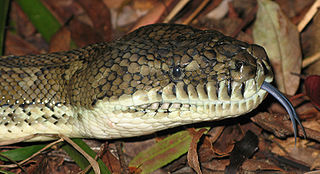 W
WA forked tongue is a tongue split into two distinct tines at the tip; this is a feature common to many species of reptiles. Reptiles smell using the tip of their tongue, and a forked tongue allows them to sense from which direction a smell is coming. Sensing from both sides of the head and following trails based on chemical cues is called tropotaxis. It is unclear whether forked-tongued reptiles can actually follow trails or if this is just a hypothesis.
 W
WA French kiss, also known as a deep kiss or a tongue kiss, is an amorous kiss in which the participants' tongues extend to touch each other's lips or tongue. A "kiss with the tongue" stimulates the partner's lips, tongue and mouth, which are sensitive to the touch and induce physiological sexual arousal. The oral zone is one of the principal erogenous zones of the body. The implication is of a slow, passionate kiss which is considered intimate, romantic, erotic or sexual. The sensation when two tongues touch, also known as "tongue touching", has been proven to stimulate endorphin release and reduce acute stress levels. French kissing is often described as ‘1st base’, and is used by many as an indicator of what stage a relationship has reached. Extended French kissing may be part of making out.
 W
WThe frenulum of tongue or tongue web is a small fold of mucous membrane extending from the floor of the mouth to the midline of the underside of the tongue.
 W
WThe genioglossus is one of the paired extrinsic muscles of the tongue. The genioglossus is the major muscle responsible for protruding the tongue.
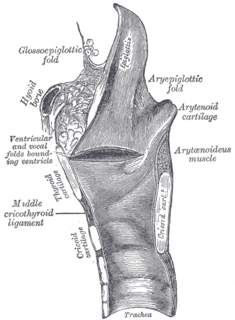 W
WThe anterior or lingual surface of the epiglottis is curved forward, and covered on its upper, free part by mucous membrane which is reflected on to the sides and root of the tongue, forming a median and two lateral glossoepiglottic folds; the lateral folds are partly attached to the wall of the pharynx.
 W
WThe hyoglossus, thin and quadrilateral, arises from the side of the body and from the whole length of the greater cornu of the hyoid bone, and passes almost vertically upward to enter the side of the tongue, between the styloglossus and the inferior longitudinal muscle of the tongue. It forms a part of the floor of submandibular triangle.
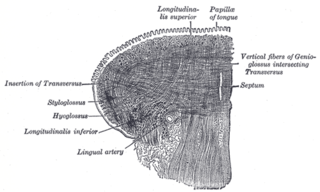 W
WThe inferior longitudinal muscle of tongue is a narrow band situated on the under surface of the tongue between the genioglossus and hyoglossus.
 W
WLicking is the action of passing the tongue over a surface, typically either to deposit saliva onto the surface, or to collect liquid, food or minerals onto the tongue for ingestion, or to communicate with other animals. Many animals both groom themselves and eat or drink by licking.
 W
WLingual papillae are the small, nipple-like structures on the upper surface of the tongue that give it its characteristic rough texture. The four types of papillae on the human tongue have different structures and are accordingly classified as circumvallate, fungiform, filiform, and foliate. All except the filiform papillae are associated with taste buds.
 W
WThe lingual septum consists of a vertical layer of fibrous tissue, extending throughout the entire length of the median plane of the tongue, though not quite reaching the dorsum. The lingual septum is closely associated with the hyoglossus membrane, allowing the binding of the tongue to the hyoid muscles.
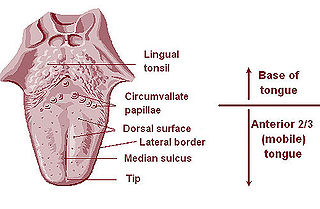 W
WThe lingual tonsils are a collection of lymphatic tissue located in the lamina propria of the root of the tongue. This lymphatic tissue consists of the lymphatic nodules rich in cells of the immune system (immunocytes). The immunocytes initiate the immune response when the lingual tonsils get in contact with invading microorganisms.
 W
WThe palatoglossus, glossopalatinus, or palatoglossal muscle is a small fleshy fasciculus, narrower in the middle than at either end, forming, with the mucous membrane covering its surface, the glossopalatine arch.
 W
WThe styloglossus, the shortest and smallest of the three styloid muscles, arises from the anterior and lateral surfaces of the styloid process near its apex, and from the stylomandibular ligament.
 W
WThe superior longitudinal muscle of tongue or superior lingualis is a thin layer of oblique and longitudinal fibers immediately underlying the mucous membrane on the dorsum of the tongue.
 W
WTaste buds contain the taste receptor cells, which are also known as gustatory cells. The taste receptors are located around the small structures known as papillae found on the upper surface of the tongue, soft palate, upper esophagus, the cheek, and epiglottis. These structures are involved in detecting the five elements of taste perception: saltiness, sourness, bitterness, sweetness and umami. A popular myth assigns these different tastes to different regions of the tongue; in fact, these tastes can be detected by any area of the tongue. Via small openings in the tongue epithelium, called taste pores, parts of the food dissolved in saliva come into contact with the taste receptors. These are located on top of the taste receptor cells that constitute the taste buds. The taste receptor cells send information detected by clusters of various receptors and ion channels to the gustatory areas of the brain via the seventh, ninth and tenth cranial nerves.
 W
WA tongue cleaner is an oral hygiene device designed to clean the coating on the upper surface of the tongue. While there is tentative benefit from the use of a tongue cleaner it is insufficient to draw clear conclusions regarding bad breath. A 2006 Cochrane review found tentative evidence of decreased levels of odor molecules.
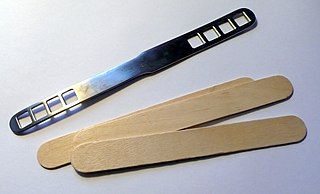 W
WA tongue depressor is a tool used in medical practice to depress the tongue to allow for examination of the mouth and throat. The most common modern tongue depressors are flat, thin, wooden blades, smoothed and rounded at both ends, but, historically, tongue depressors have been made of a variety of materials. Since they are inexpensive and difficult to clean because of their porous texture, wooden tongue depressors are labeled for disposal after a single usage.
 W
WA tongue frenulum piercing or the tongue web piercing is a body piercing through the frenulum underneath the tongue. These piercings are relatively simple piercings, and heal quickly, although they do have a tendency to reject over time. Depending on the anatomy of the individual, this piercing may not be feasible. A web piercing may be considerably painful.
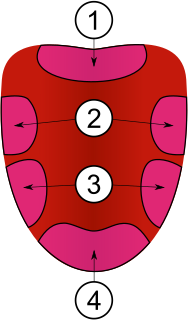 W
WThe tongue map or taste map is a common misconception that different sections of the tongue are exclusively responsible for different basic tastes. It is illustrated with a schematic map of the tongue, with certain parts of the tongue labeled for each taste. Although widely taught in schools, this has been scientifically disproved by later research; all taste sensations come from all regions of the tongue, although different parts are more sensitive to certain tastes.
 W
WA tongue piercing is a body piercing usually done directly through the center of the tongue. Since its decline in popularity around 2011, it has seen a recent upsurge making it now the second most popular piercing amongst young women aged 18-25 in 2019. It remains unpopular amongst men. Standard tongue piercings, or one hole in the center of the tongue, is the most common and safest way to have the tongue pierced.
 W
WIn linguistics, specifically articulatory phonetics, tongue shape describes the shape that the tongue assumes when it makes a sound. Because the sibilant sounds have such a high perceptual prominence, tongue shape is particularly important; small changes in tongue shape are easily audible and can be used to produce different speech sounds, even within a given language.
 W
WTongue bifurcation, splitting or forking, is a type of body modification in which the tongue is cut centrally from its tip to as far back as the underside base, forking the end.
 W
WTongue toast is a traditional open sandwich prepared with sauteed beef tongue and scrambled eggs. It is seasoned to taste with black pepper and onions. The tongue was sometimes served on buttered toast with a poached egg instead of a scrambled one. While it was primarily prepared as a dish for breakfast, it was also eaten for lunch and dinner.
 W
WTransient lingual papillitis are painful, hypertrophic, red and white lingual papillae on the tongue.
 W
WThe transverse muscle of tongue (transversus linguae) is an intrinsic muscle of the tongue. It consists of fibers which arise from the median fibrous septum and pass lateralward to be inserted into the submucous fibrous tissue at the sides of the tongue.
 W
WThe vertical muscle is an intrinsic muscle of the tongue. It is found only at the borders of the forepart of the tongue.
 W
W